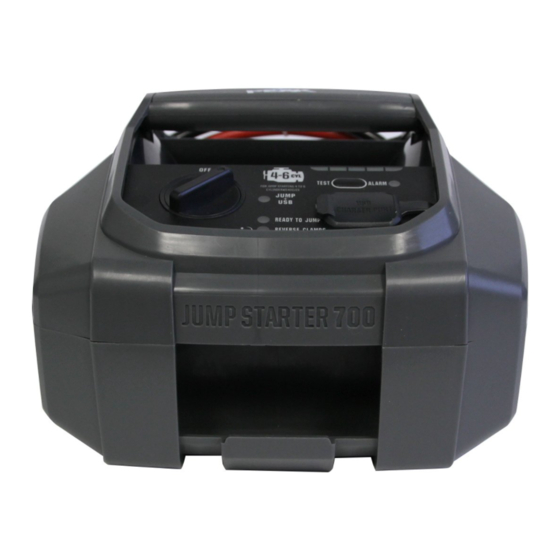
Summary of Contents for Peak PKC0J700
- Page 1 700 Peak Amp Jump-Starter Model No.: PKC0J700 Owner’s Manual and Warranty Information Read these instructions completely before using this product. Retain this Owner’s Manual for future reference. 2/17 © 2017...
-
Page 2: Table Of Contents
CONTENTS SAFETY PRECAUTIONS ........................ 2 Jump-Starter Safety ........................ 2 Battery Jump-Starting Safety ....................3 INTRODUCTION ..........................4 FEATURES ............................4 SPECIFICATIONS ........................... 6 OPERATION ............................ 6 Checking Jump-Starter Battery Status ..................6 ....................6 Alarm - LCA Low Charge Alert ®... -
Page 3: Battery Jump-Starting Safety
Battery Jump-Starting Safety EXPLOSIVE GASES — Do not use this product in the presence of flammable fumes or gases. Working in the vicinity of a lead-acid battery can cause an explosion of the battery being charged. When lead-acid batteries are charging, they vent explosive hydrogen gas, which can be ignited by sparks from electrical connections. -
Page 4: Introduction
• Do not use any accessory that is not recommended or provided by the manufacturer. INTRODUCTION The 700 Peak Amp Jump-Starter can supply DC voltage power. It can be used to jump-start 12-volt DC batteries. It also comes equipped with 2 USB power ports that will allow you to charge or power devices. - Page 5 9, 10 Legend Red Positive (+) Jumper Cable 2 USB Ports Worklight ON/OFF Button 10. 110-volt AC Charging Port Black Negative (–) Jumper Cable 11. Charger Storage Area 5 LED Worklight 12. Reverse Clamps Red LED Indicator Ergonomic Carrying Handle 13.
-
Page 6: Specifications
SPECIFICATIONS Built-in battery 12-volt rechargeable, lead-acid, AGM (Absorbed Glass Mat) battery 2 USB power 5 volts/2400 mA maximum ports Worklight Five non-replaceable LEDs Charging time AC charging – initial charge time 24 hours; typical charge time 14 to 18 hours OPERATION Checking Jump-Starter Battery Status Legend... -
Page 7: Charging Jump-Starter Battery
Charging Jump-Starter Battery All rechargeable batteries gradually discharge when left idle, and you need to recharge them periodically to maintain maximum battery capacity. The AC charger is designed to charge using a 110/120-volt outlet. • Fully charge unit to the recommended maximum and initial charge time of 24 hours. Thereafter, an AC typical charge time is 14 to 18 hours. -
Page 8: Usb Power Ports Operation
Connect the black negative (–) cable to a non-moving metal part on the vehicle. Do not connect to the negative (–) battery terminal. Make sure the red reverse clamps light is not on. If it is on, the jump-start cables are not installed correctly. Immediately stop and recheck your connections. Only continue if the red reverse clamp indicator is NOT lit and the Blue Ready to Jump indicator is lit. -
Page 9: Care And Maintenance
CARE AND MAINTENANCE Storage Store the Jump-Starter at room temperature. Make sure the battery clamps are stored on the appropriate case clamp posts on the side of the unit after use. Due to inherent self-discharge, lead acid batteries should be charged at least every 4 months, especially in a warm environment. -
Page 10: Limited Warranty
Manufacturer warrants to the original consumer, or purchaser, that the PEAK® 700 Peak Amp Jump- Starter PKC0J700 will be free from defects in material and workmanship for one year from the date of sale to the original purchaser. Manufacturer hereby excludes and disclaims any and all other warranties, expressed or implied, beyond those warranties specified above.





Need help?
Do you have a question about the PKC0J700 and is the answer not in the manual?
Questions and answers